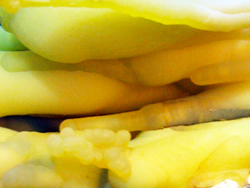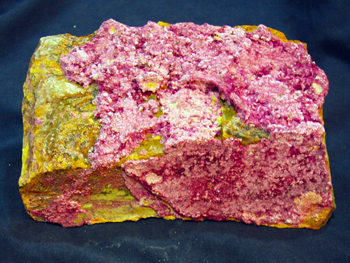 |
 |

Chalcedony from Gatton area, south-east
Queensland.
Minerals Heritage Museum
Display location:
Queensland Museum
Southbank, Brisbane, Queensland, Australia
(Mezzanine Floor)
Display Hours:
Open daily from 9.30am - 5.00pm.
Closed Good Friday, Christmas Day & Boxing Day. Open ANZAC Day from
1.30 pm.
General admission: Free.
About the museum
History of the MHM
Aims of the MHM
The MHM Trustees
About the museum
History of the MHM
Aims of the MHM
The MHM Trustees
If you want to view mineral and crystal specimens in Queensland, you have very few options available to you. With Queensland's secondary school curriculum now including earth sciences modules, it is more important than ever to educate our young about these wonders of nature, and to do that we need a resource like the Minerals Heritage Museum.
|
Background |
 Erythrite from Mt Cobalt, north- west Queensland (MHM specimen #60). |
Queensland has a rich history of mining, and for over 100 years many beautiful mineral specimens made their way into the collections of the Queensland Museum, Queensland Geological Survey and the University of Queensland from rich the mining towns of Gympie, Charters Towers, Cloncurry and Mt Isa.
What happened to
Queensland's mineral heritage?
Unfortunately, due in part to a lack of funding, changing institutional
focus and an absence of curation, a wonderful and rare public resource was
eventually sold, damaged, pilfered and lost before being eventually
removed from public view. Once the
Recognising this vacuum, the members of the Mineralogical Society of
Queensland set about creating our own museum, the
In the beginning the
museum was but a dream for the future. It had no specimens and no display
venue, but it had a great vision for what was required. A lot of effort
was put in early so that the MHM gained approval from the Australian Taxation Office to operate as a not-for-profit body with tax deductibility
status under the Cultural Gifts Program. The MHM saw this as an important
avenue to gain the aid we required if we were to be taken seriously by
serious collectors and mining companies. We made our prime aim to focus on
Australian and
Our first curator, the late Ron Young, worked tirelessly to see the first permanent MHM display opened by the Chairman of Enertrade, Bernard Rowley, in 2004. The collection has grown considerably from purchases and donations by companies and individuals to now consist of over
700 mineral specimens. The very best of these specimens are displayed in
five large display cabinets located within the Queensland Museum at
Southbank, Brisbane. Although not large physically, it is by far and away, the finest mineral display in south-east Queensland.
~
Preserving Australia's Mineral Heritage ~
Copyright MHM 2015 -
The Minerals Heritage Museum is a not-for-profit institution
based in Brisbane.